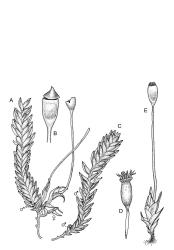- ≡ Sainsburia novae-zealandiae Dixon, Bryologist 44: 40 (1941)
- ≡ Fissidens taylorii var. sainsburiana Allison, Trans. Roy. Soc. New Zealand 88: 9 (1960) nom. inval.
- = Fissidens brevifolius Hook.f. & Wilson in Wilson, Bot. Antarct. Voy. II (Fl. Nov.-Zel.) Part II, 61 (1854)
Leaves in 8–12 pairs, 0.4–0.7 × 0.15–0.20 mm; cells of apical and dorsal laminae (6–)7.5–12(–18) × (7–)7.5–10(–12) µm. Costa subpercurrent to percurrent.
Perichaetia terminal on short shoots, axillary at base of otherwise sterile shoots or apparently independent. Perigonia bud-like, at base of sterile or perichaetial shoots. Peristome sainsburia-type. Calyptra smooth, cucullate. Spores 15–25 µm.
Wilson 1854, pl. 83, fig. 4 (as F. brevifolius); Stone & Beever 1996, figs 2, b, d, 3, b, d, 7, a–m; Beever et al. 2002, p. 66, figs 1–6.
This variety was originally described by Dixon (1941) as a monotypic genus, Sainsburia, owing to its peristome, in which the teeth are not split (sainsburia-type). The distinct peristome was regarded as taxonomically unimportant by Sainsbury (1955) who reduced Sainsburia novae-zealandiae to a synonym of F. taylorii, noting it was "a form marked by the teeth being cracked and erect instead of divided and incurved". Varietal status was proposed by Allison (1960), but the new combination was not validly published.
Bruggeman-Nannenga & Berendsen (1990) noted that, in addition to the gross morphology of the peristome teeth being anomalous in Fissidens, so also was the ornamentation. With SEM the rimose teeth are seen to have areas of thin, unornamented lamella in their mid line, adjacent to the original vertical walls of the component cells of the adaxial face of the teeth (Stone & Beever 1996, fig. 2d). A similar lack of ornamentation can occur at corresponding positions on the abaxial face. Tears (or perhaps dissolution) in this thin area result in a fenestrate tooth. The present author confirms the observations of Allison (1960) and Bruggeman-Nannenga & Berendsen (1990) that transitional forms between the sainsburia-type peristome and the bryoides-type of F. taylorii var. taylorii are not seen.
Teeth similar in form to the sainsburia-type are found in the Grimmiaceae, e.g., in Schistidium apocarpum (see Edwards 1984, figs 4, d, 7, n). The ornamentation of the teeth is also similar in S. apocarpum, the lamellae being densely papillose on both adaxial and abaxial faces of the teeth.
Considering the weight generally given to peristome morphology in the classification of mosses (see e.g., Vitt et al. 1998), the current nomenclatural status given to F. taylorii var. sainsburyanus is unusual.
K; NI: S Auckland, Hawke’s Bay, Wellington; SI: Nelson, Marlborough, Canterbury, Otago.
Australasian. Tasmania*, mainland Australia*.
Fissidens taylorii var. sainsburyanus occurs on bare soil, shaded or semi-shaded, often under exotic trees in urban settings such as parks or cemeteries, but also occasionally in indigenous vegetation. Associated mosses include F. curvatus var. inclinabilis, F. leptocladus and F. taylorii var. taylorii, as well as Bryum argenteum and Weissia controversa.
Records range from 20–60 m elevation.






